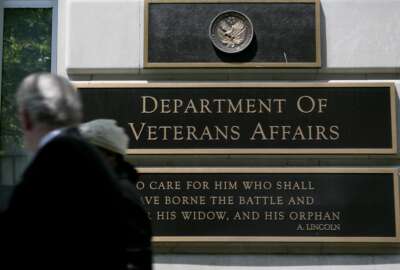

The Veterans Health Administration is seeing severe staffing shortages back on the rise, after years of making progress on this front.
The Veterans Health Administration is seeing severe staffing shortages back on the rise, after years of making progress on this front.
The Veterans Affairs Department’s inspector general office, in a report released Thursday, found all 139 VHA facilities it surveyed this year reported at least one severe occupational staffing shortage.
In total, the VA IG’s report found 2,622 severe staffing shortages for 285 occupations in VHA nationwide.
The overall number of current VHA staffing shortages remains lower than what the agency reported in 2018. But it also marks the first report in recent years in which the VHA didn’t continue to decrease the overall number of occupations with staffing shortages.
“For the first time since reporting to the facility level, there was a net increase in severe occupational staffing shortages suggesting it was more difficult to fill positions in VHA,” the report states.

The report finds the VHA in FY 22 saw a 22% increase in severe staffing shortages, compared to the year prior. The agency saw year-over-year reductions in staffing shortages in 2019, 2020 and 2021.
Deputy Undersecretary for Health Steven Lieberman told the IG’s office that the impact of the COVID-19 pandemic on the health care workforce and the shortage of physicians and nurses across the entire labor market “has driven and continues to drive the shortage across health care as documented by the Bureau of Labor Statistics.”
The VA has seen record-high turnover among its health care workforce since the start of the COVID-19 pandemic. The agency has called on Congress to pass legislation that would raise caps for health care positions and make permanent some pandemic-era hiring authorities.
The VA is also preparing to transform its workforce and health care facilities in anticipation of legislation that would deliver a historic expansion of health care to veterans.
The Senate last month passed the Sergeant First Class Heath Robinson Honoring our Promise to Address Comprehensive Toxics (Honoring Our PACT) Act. The bill is now back in the House waiting for a final floor before heading to President Joe Biden’s desk.
VA Secretary Denis McDonough told the Senate VA Committee in June that the PACT Act would give the VA much-needed authority to set higher pay caps for certain health care positions, and that the VA’s ability to get veterans into care more quickly is “obviously impacted by the tightness of the labor market.”
The VHA continues to face long-standing challenges in keeping enough medical officers and nurses.
The report finds that 87% of facilities experienced severe occupational staffing shortages for medical officers, and 91% reported severe shortages for nurses. The VA IG has noted a severe shortage of these positions every year since 2014.
This year’s report marks the first in which the IG’s office found more than 90 occupations facing severe shortages.
“In FY 2022, more severe occupational staffing shortages were reported by more facilities than in recent FYs. Although VHA experienced net increases in onboard staffing levels of certain occupations, severe occupational staffing shortages continued to exist. The OIG acknowledges that the COVID-19 Pandemic affected VHA’s delivery of healthcare and their staffing needs,” the report states.
The Grand Junction VA Medical Center in Colorado and the Palo Alto VA Medical Center in California both reported 89 staffing shortages in this year’s report — the most shortages reported by any one VA facility.
The report finds seven occupations that have remained in the top 10 most frequently reported severe shortages annually: police, psychiatry, primary care, practical nurse, general engineering psychology and medical technologist.
However, the IG found that VHA has generally seen net increases in staffing levels for each of these seven occupations every year since FY 2017.
“Therefore, although these occupations were identified as severe occupational staffing shortages, VHA has been increasing the number of staff in these occupations,” the report states.
The IG also identified five occupations that saw the biggest increase in facilities reporting severe shortages between FY 2022 and FY 2021. These include custodial workers, practical nurses, medical support assistants, nursing assistants and registered nurses.
“The OIG believes this comparison provides VHA with insight into which occupations may benefit from additional workforce planning strategies,” the report states.
The IG found that 63% of VA facilities reported a severe shortage of medical support assistants, the more critical staff shortage among Title 38 occupations VHA is able to non-competitively select individuals using direct-hire authority for Title 38 positions.
The VA IG’s office, under the 2017 Choice and Quality Employment Act, is required to identify staffing shortages across the agency’s clinical and non-clinical positions.
The VA, meanwhile, faces a 23% vacancy rate for licensed professional mental health counselors (LPMHCs), as well as marriage and family therapists (MFTs).
Senate VA Committee Chairman Jon Tester (D-Mont.) and Ranking Member Jerry Moran (R-Kan.) are seeking an update from the VA and the Office of Personnel Management on steps to bring more of these personnel onboard.
The senators, in a letter to McDonough and OPM Director Kiran Ahuja, seek an update under the 2020 Commander John Scott Hannon Veterans Mental Health Care Improvement Act, which requires the agencies to create a new federal occupational series for these specialists.
“Creating an occupational series for LPMHCs and MFTs is integral to ensuring streamlined hiring of these mental health care professionals and delivering timely mental health care to veterans. The absence of an occupational series for these two positions can add difficulties to the hiring process for human resources personnel attempting to fill vacancies and candidates researching and applying for positions at VA,” the senators wrote.
VA officials briefed lawmakers on the implementation of the Hannon Act last November. Tester and Moran said OPM last October had agreed to establish an Integrated Project Team (IPT) to create an occupational series for LPMHCs and MFTs.
“This briefing provided no timeline regarding the IPT’s course of action, and now, nearly seven months later, we have received no update on the work of the IPT or a projection for completion of the occupational series for LPMHCs and MFTs. This is also troubling given we have been asking VA and OPM since 2017 to establish an occupational series for these mental health professionals,” the senators wrote.
Copyright © 2024 Federal News Network. All rights reserved. This website is not intended for users located within the European Economic Area.
Jory Heckman is a reporter at Federal News Network covering U.S. Postal Service, IRS, big data and technology issues.
Follow @jheckmanWFED



